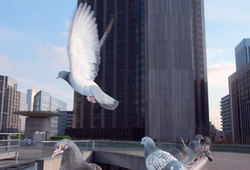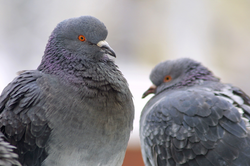
By Arlene Connelly
Many urban dwellers are unaware that more than 60 human diseases — including avian flu, salmonella, E coli and West Nile virus — are related to pigeons, other pest birds and their droppings. Besides being a public health issue in many cities, they often create a safety hazard for pedestrians, and they carry dangerous parasites and harmful bacteria. Some of these illnesses can even be fatal to humans; they can be contracted through contact with the skin and exposure through inhalation as people go about their daily activities.
Why pest pigeons are especially dangerous
Pigeons are generally considered to be “the number one bird pest” in America today, their numbers are increasing, and their nesting instincts are strong. They usually mate for life, live in communal flocks that travel together, and tend to roost where they can find adequate food and shelter. Along with that, experts in the field now consider pigeons to be a genuine “urban menace,” threatening the quality of life in America’s great cities, including San Francisco, Chicago and New York.
Pigeon droppings can be found on walkways, roofs, window ledges and the sides of some of our finest buildings— anyplace these birds can access. This is especially dangerous around air vents and areas that surround water sources; the germs they carry can easily be transmitted to humans, especially those with a weakened immune system. They also attract insects that can spread disease as well, creating serious liability issues for businesses and restaurateurs.
The corrosive affect of pest pigeon droppings results in extensive and expensive damage to our public buildings and monuments, and they can cause a serious disaster like the collapse of the Minnesota Bridge. Feathers, droppings and nest paraphernalia can also be sucked into pipes and vents, creating a fire hazard in a city’s high-rise buildings where people work and live.
Many urban dwellers are unaware that more than 60 human diseases — including avian flu, salmonella, E coli and West Nile virus — are related to pigeons, other pest birds and their droppings. Besides being a public health issue in many cities, they often create a safety hazard for pedestrians, and they carry dangerous parasites and harmful bacteria. Some of these illnesses can even be fatal to humans; they can be contracted through contact with the skin and exposure through inhalation as people go about their daily activities.
Why pest pigeons are especially dangerous
Pigeons are generally considered to be “the number one bird pest” in America today, their numbers are increasing, and their nesting instincts are strong. They usually mate for life, live in communal flocks that travel together, and tend to roost where they can find adequate food and shelter. Along with that, experts in the field now consider pigeons to be a genuine “urban menace,” threatening the quality of life in America’s great cities, including San Francisco, Chicago and New York.
Pigeon droppings can be found on walkways, roofs, window ledges and the sides of some of our finest buildings— anyplace these birds can access. This is especially dangerous around air vents and areas that surround water sources; the germs they carry can easily be transmitted to humans, especially those with a weakened immune system. They also attract insects that can spread disease as well, creating serious liability issues for businesses and restaurateurs.
The corrosive affect of pest pigeon droppings results in extensive and expensive damage to our public buildings and monuments, and they can cause a serious disaster like the collapse of the Minnesota Bridge. Feathers, droppings and nest paraphernalia can also be sucked into pipes and vents, creating a fire hazard in a city’s high-rise buildings where people work and live.

 RSS Feed
RSS Feed